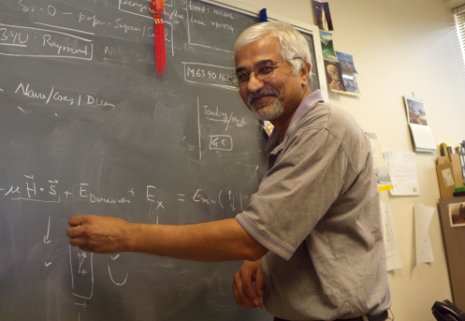Home > Press > Michigan Tech Team Models Molecular Transistor
 |
| Ravi Pandey at the blackboard |
Abstract:
Electronic gadgetry gets tinier and more powerful all the time, but at some point, the transistors and myriad other component parts will get so little they won't work. That's because when things get really small, the regular rules of Newtonian physics quit and the weird rules of quantum mechanics kick in. When that happens, as physics professor and chair Ravindra Pandey puts it, "everything goes haywire."
Michigan Tech Team Models Molecular Transistor
Houghton, MI | Posted on August 12th, 2009Theorists in the field of molecular electronics hope to get around the problem by designing components out of a single molecule. Pandey's group has done just that—theoretically—by modeling a single-molecule field-effect transistor on a computer.
"Transistor" has been an oft-used but rarely understood household word since cheap Japanese radios flooded the US market back in the 1960s. Field-effect transistors form the basis of all integrated circuits, which in turn are the foundation of all modern electronics.
A simple switch either diverts current or shuts it off. Transistors can also amplify the current by applying voltage to it (that's how amplifiers work).
A diagram of Pandey's three-terminal single-molecule transistor looks like an elaborate necklace and pendant, made up of six-sided rings of carbon atoms bedecked with hydrogen and nitrogen atoms. His group demonstrated that the electrical current running from the source to the drain (through the necklace) rises dramatically when voltage applied at the gate (through the pendant) reaches a certain level.
This happens when electrons in the current suddenly move from one orbital path around their atoms to another. Or, as Pandey says, "Molecular orbital energies appear to contribute to the enhancement of the source-drain current."
Their virtual molecule may soon exist outside a computer. "Several experimental groups are working to make real our theoretical results," says Pandey.
An article on the molecular transistor, "Electronic Conduction in a Model Three-Terminal Molecular Transistor," was published in 2008 in the journal Nanotechnology, volume 19. Coauthors are physics graduate student Haying Hay and Sashi Karna of the Army Research Lab.
####
About Michigan Tech
Michigan Tech was founded in 1885 in response to the first mining boom in the U.S. — the clamor for Michigan's copper, which preceded the California Gold Rush by several years.
At its outset, the college trained mining and metallurgical engineers. Today, the University offers certificates, associate, bachelors, masters, and doctoral degrees in arts, humanities, and social sciences; business and economics; computing; engineering, forestry and environmental science, sciences; and technology.
For more information, please click here
Contacts:
Marcia Goodrich
906-487-2343,
Copyright © Michigan Tech
If you have a comment, please Contact us.Issuers of news releases, not 7th Wave, Inc. or Nanotechnology Now, are solely responsible for the accuracy of the content.
| Related News Press |
News and information
![]() Researchers develop molecular qubits that communicate at telecom frequencies October 3rd, 2025
Researchers develop molecular qubits that communicate at telecom frequencies October 3rd, 2025
![]() Next-generation quantum communication October 3rd, 2025
Next-generation quantum communication October 3rd, 2025
![]() "Nanoreactor" cage uses visible light for catalytic and ultra-selective cross-cycloadditions October 3rd, 2025
"Nanoreactor" cage uses visible light for catalytic and ultra-selective cross-cycloadditions October 3rd, 2025
Chip Technology
![]() Lab to industry: InSe wafer-scale breakthrough for future electronics August 8th, 2025
Lab to industry: InSe wafer-scale breakthrough for future electronics August 8th, 2025
![]() A 1960s idea inspires NBI researchers to study hitherto inaccessible quantum states June 6th, 2025
A 1960s idea inspires NBI researchers to study hitherto inaccessible quantum states June 6th, 2025
![]() Programmable electron-induced color router array May 14th, 2025
Programmable electron-induced color router array May 14th, 2025
Nanoelectronics
![]() Lab to industry: InSe wafer-scale breakthrough for future electronics August 8th, 2025
Lab to industry: InSe wafer-scale breakthrough for future electronics August 8th, 2025
![]() Interdisciplinary: Rice team tackles the future of semiconductors Multiferroics could be the key to ultralow-energy computing October 6th, 2023
Interdisciplinary: Rice team tackles the future of semiconductors Multiferroics could be the key to ultralow-energy computing October 6th, 2023
![]() Key element for a scalable quantum computer: Physicists from Forschungszentrum Jülich and RWTH Aachen University demonstrate electron transport on a quantum chip September 23rd, 2022
Key element for a scalable quantum computer: Physicists from Forschungszentrum Jülich and RWTH Aachen University demonstrate electron transport on a quantum chip September 23rd, 2022
![]() Reduced power consumption in semiconductor devices September 23rd, 2022
Reduced power consumption in semiconductor devices September 23rd, 2022
Announcements
![]() Rice membrane extracts lithium from brines with greater speed, less waste October 3rd, 2025
Rice membrane extracts lithium from brines with greater speed, less waste October 3rd, 2025
![]() Researchers develop molecular qubits that communicate at telecom frequencies October 3rd, 2025
Researchers develop molecular qubits that communicate at telecom frequencies October 3rd, 2025
![]() Next-generation quantum communication October 3rd, 2025
Next-generation quantum communication October 3rd, 2025
![]() "Nanoreactor" cage uses visible light for catalytic and ultra-selective cross-cycloadditions October 3rd, 2025
"Nanoreactor" cage uses visible light for catalytic and ultra-selective cross-cycloadditions October 3rd, 2025
|
|
||
|
|
||
| The latest news from around the world, FREE | ||
|
|
||
|
|
||
| Premium Products | ||
|
|
||
|
Only the news you want to read!
Learn More |
||
|
|
||
|
Full-service, expert consulting
Learn More |
||
|
|
||








